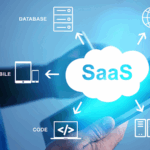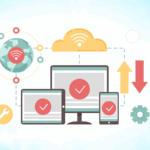From Concept to Launch: How SaaS Application Development Services Build Scalable Products
November 14, 2025 | 0 Comments
info@trickywebsolutions.com |
+1-225-276-2741
 USA
USA IN
IN
 SG
SG
 PT
PT
Initially, many companies go for a “lift-and-shift“ approach to transfer their company’s data and application from in-house infrastructure to a cloud environment. However, later, they realize that cloud migration is much more complicated than it initially seems. Cloud migration is not merely about moving assets, but also involves managing risks, shielding sensitive information, and securing cloud applications along the way. This is where cloud migration service providers become very important and assist in streamlining and managing the process smoothly. In this blog, we will discover how you can shift from on-site infrastructure to a cloud environment with various cloud migration solutions and cloud migration best practices.
Cloud migration is the process of moving a firm’s infrastructure, such as data, services, applications, and other key components, to a new cloud environment with a successful cloud migration plan. There are a number of popular cloud vendors that assist organizations in migrating from their on-premises infrastructure to cloud infrastructure. Some of which are AWS, Microsoft Azure, Google Cloud Platform, IBM Cloud, Alibaba Cloud, and there are numerous others. These software migration services enable organizations to make their business more scalable and flexible with a minimum budget.
Below we have listed a few commonly used cloud migration solutions offered by some well-known organizations and utilized by various organizations:
AWS Migration Hub is one of the cloud migration services provided by Amazon Web Services. It supports rehosting and lift-and-shift strategies for migrating workloads from in-house infrastructure to AWS. The tool is highly automated and is commonly used by many big enterprises that are transitioning their data centers to the AWS ecosystem. A typical migration costs around $5,000 and takes approximately 30 days to complete, with strong customer satisfaction (average rating: 4.6/5).
Azure Migrate by Microsoft is another best cloud migration solutions widely used for migrating on-premise environments to Azure. It supports both rehost and refactor approaches and offers deep integration with Windows Server and SQL Server environments. It’s also highly automated. On average, migration costs are $4,500, taking about 25 days, with a customer rating of 4.5/5.
This is Google’s Key resource for VM migrations to Google Cloud. It emphasizes lift-and-shift migration with moderate automation levels, best suited for virtual machine migrations from on-premise environments. Migration with this tool costs around an average of $4,000 and takes approximately 28 days, with a rating of 4.4.
VMware HCX, another popular cloud migration platform, enables hybrid migrations to cloud infrastructures like AWS, Azure, Google Cloud, and VMware Cloud. It’s perfect for companies already committed to VMware infrastructure and seeking an effortless rehosting route. This solution typically costs $5,200 and takes about 35 days, with a customer satisfaction rating of 4.3.
This cloud migration solution provides migration planning and performance assurance across AWS, Azure, and IBM Cloud. It supports rehosting and replatforming. Best suited for enterprises with application performance requirements, it averages $6,000 in cost and 32 days to complete, with a rating of 4.2.
CloudEndure Migration is another cloud migration solution offered by AWS, designed for fast, automated lift-and-shift migrations and disaster recovery. This service is most known for its highly automated process that takes very little time to deliver projects. It takes around 20 days to complete the project with a cost of $4,800 and has a high customer rating of 4.6.
Accenture myNav is more than a migration tool—it’s a cloud readiness and strategy platform that helps assess and plan migrations to AWS, Azure, or Google Cloud. Best for modernization and transformation projects, it costs roughly $7,000 and takes around 40 days to execute, with a customer rating of 4.3.
There are mainly 7 commonly used cloud migration strategies which we have listed below and have explained each briefly:
This cloud migration strategy applies to applications that are ready to be removed or archived. Application retirement enables you to decommission the related servers and infrastructure. It’s usually applied to old, redundant, or low-business-value applications that no longer support the business and can be removed without harm from the IT environment.
Rehost is the best cloud migration strategy for software systems that we don’t want to remove yet, but also don’t want to migrate at the moment. It includes software that you could migrate later when needed.
This is a “lift and shift” strategy by which software is relocated from the source environment to the AWS Cloud without changing the application. You can take an example of shifting the whole application stack from an On-site environment to AWS directly. Rehost helps organizations transfer all their data and servers from multiple platforms without any worry.
This approach allows the migration of several servers, which may support one or more applications, at once from an on-premises platform to a cloud version of the same platform. This method is also applicable to migrate resources like instances or objects between different Virtual Private Clouds or AWS accounts.
This cloud migration strategy is also called drop and shop. This strategy allows you to exchange your software with something else that offers additional features and services than the existing one. Repurchasing minimizes the overall cost involved with maintaining the infrastructure.
Other names of replatforming are tinker, reshape, lift, or shift. This cloud migration strategy enables organizations to transfer their software application to the cloud with some changes made to minimize cost and run the software effectively.
This strategy includes moving an application to the cloud and re-architecting it to maximize cloud-native features. The aim is to increase agility, performance, and scalability, to respond to expanding business requirements, speed up product and feature delivery, and decrease operating expenses.
Migrating the on-premises infrastructure into a cloud environment requires careful planning, strategy, and compliance with best practices to make sure an effortless transition. We have curated this section to describe the cloud migration best practices to follow:
Analyzing and ranking software and servers before migration requires a thorough review of your current IT environment. This includes analysing each system, software assets, and operational processes to identify which systems are best suited for the cloud and what advantages, such as improved performance, cost savings, or scalability migration, could bring.
Before you opt for cloud migration, it is important to map system dependencies. This process includes analyzing the interconnections between different applications and services. Knowing the interconnections between different elements is crucial, as they can cause service disruptions or failure after migration.
Creating a detailed migration plan and designing the desired cloud architecture is important to make sure the migration is smooth and seamless. This requires detailed planning, attention to detail, and analysis of each critical function.
There are many cloud service providers available out there providing top-notch cloud software migration solutions. But when it comes to selecting one, you might get confused about which one would be the best for your organization. Here are some factors to consider while choosing one:
Recent Posts

From Concept to Launch: How SaaS Application Development Services Build Scalable Products
November 14, 2025 | 0 Comments

Agentic AI: The Rise of Autonomous Decision-Makers in a Human-Centric World
November 12, 2025 | 0 Comments

Empowering Growth: Cutting-Edge SaaS Application Development Solutions
November 10, 2025 | 0 Comments

Step into Web Design & Development: Creative Solutions That Elevate Your Presence
November 3, 2025 | 0 Comments

Supercharge Your eCommerce: Innovative Mobile App Development Solutions
October 31, 2025 | 0 Comments

Building the Future: Scalable & Agile Cloud Native App Development Solutions
October 30, 2025 | 0 Comments
Categories

We will zealously try to help you by providing technical support. We are open to inquiries or requests.
info@trickywebsolutions.com
1945 Brightside Drive, Baton Rouge, LA -70820
We are available for a friendly chat to discuss your business needs, no obligation.